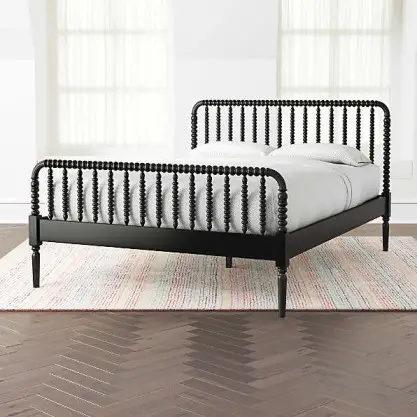We’ve come to know and be familiar with the Jenny Lind bed – a spool bed with square corners on the head and foot boards. But do you know how this type of furniture got its household name? Contrary to popular beliefs, Jenny Lind is neither a brand nor furniture maker. Thanks to a certain entertainer in the 1850s, her name became associated for a popular bedframe has remained stuck with it ever since.
Ever curious as to how the classic furniture came to be? Read on below to find out more about its history.
Who was Jenny Lind?
Jenny Lind was a very popular Swedish opera singer who got her big American break in 1851. While she had a good following in Europe, she was not particularly known in the States. It also didn’t help that the States’ musical entertainment scene had not gained traction. Renowned American showman, P.T. Barnum, took this opportunity to boost the entertainment scene by promoting Lind’s talent. He coordinated her American tour and as part of its promotion, Barnum allowed her image to be used to market almost anything and everything.
The “Swedish Nightingale” quickly became recognized, so much so that around 40,000 people showed up to greet the arrival of her ship. Her concert received high praises and word-of-mouth spread, leading Barnum to extend her tour to 93 concerts. The Divine Jenny’s innocent image, benevolence, and stunning voice, was reinforced by the fact that she didn’t keep any of the profits made from her tour. In addition to Barnum’s profits, Lind donated her earnings to charities and Swedish schools.
How did the Jenny Lind Bed come about?
P.T. Barnum took the liberty of taking her image to create a buzz by making the ‘Jenny Lind’ brand. This included Jenny Lind hats and gloves, Jenny Lind tobacco, and of course, Jenny Lind beds. There have even been reports about Lind using the spool-design bed during her American tour, further creating buzz around this furniture.
The modest design of this type of bed is also popular among baby and children’s furniture. The cottage-style spindled furniture can often be found in cribs. This connection also further reinforced Lind’s innocent nature that Barnum tried to promote during her American tour. It seems that Barnum’s promotional tactics have been effective, as the Jenny Lind bed design is still very much known children’s furniture today.
History of the Jenny Lind Furniture
Today, the style is still associated with simple furniture, mostly for beds, cribs, and dressers. While this style became popular due to the Swedish singer, it has had a history prior to 1850. It was mostly referred to as “spool-turned furniture”, which was widely manufactured in the late 19th century. This furniture earned a reputation as déclassé Victoriana, which received some attention from museums and collectors.
Interestingly, wood turning had been practiced by the Romans. It wasn’t until 16th century England, where this technique was rediscovered. Although it was in fashion in the 19th century, the spool design was common in colonial furniture. Colonial woodworkers were highly enthusiastic in the turning wood technique. They were very into the technique that most of their furniture pieces were always decorated with this method, making it the emblem of colonial style.
The furniture identified by its turned rails and embellishments have been made since around 1820. While foot pedal-powered lathes had been used to create wood for furniture, steam and water-powered factories began taking over to manufacture spool-turned furniture. It wasn’t until around 20 years later that automation of this process made this type of furniture affordable for the masses.
The Jenny Lind Bed Design
In the context of today’s modern furniture design, the Jenny Lind Bed has a vintage feel. What you see as the spindled bed frame, is more accurately defined as ball-turned or button-turned. Ball-turn refers to the round shape of the turning, while buttoned-turned is the lathe technique that is often used by button makers. This is where a rod is shaped into a series of small balls and then sawn apart to create the distinctive shape. There are many other ways to describe these methods, including bobbin, sausage, knob, and vase-and-ring turnings. However, their mimicking ornate is the commonality.
The Jenny Lind bed is also known as the spool bed due to its resemblance to sewing pools. Early models of spool-turned beds were characterized as having straight lengths of turnings, as this was the easiest to make. Around 1830, these beds had headboards and footboards that are about the same height. Thanks to a new method of bending spool turnings, spool-turners would make spool-turned furniture with rounded corners in the 1850s. However, a truly, authentic Jenny Lind bed design would have square solid corners on the headboard.
Furnishing a Home with a Jenny Lind Bed and Furniture
While we are now spoiled with more contemporary choices of beds and other furniture, there may still be room for a classic piece. Vintage Jenny Lind beds can be found in flea markets, while furniture shops have been known to do their own take of the timeless design. Many spool-turned beds and furniture have been made from different types of wood including, maple, mahogany, cherry, poplar, and cottonwood. You may even consider painting over or staining the wood to a color of your liking to give it a fresh new look.
A vintage spool-turned bed, dresser, or table can add some character to a home. They can look fitting in both dark and moody bedrooms, as well as bright and cheerful bedrooms. Depending on your style and preference, you can play around with combinations of bedding to complement the Jenny Lind bed. Pair the vintage bed frame with a mix and match of complementary colors or a more neutral color combination, like white and beige to suit a natural wood-color frame. If going for bolder textures is more your thing, such as ruffled bedding, the simple nature of the frame will complement it nicely as well.

